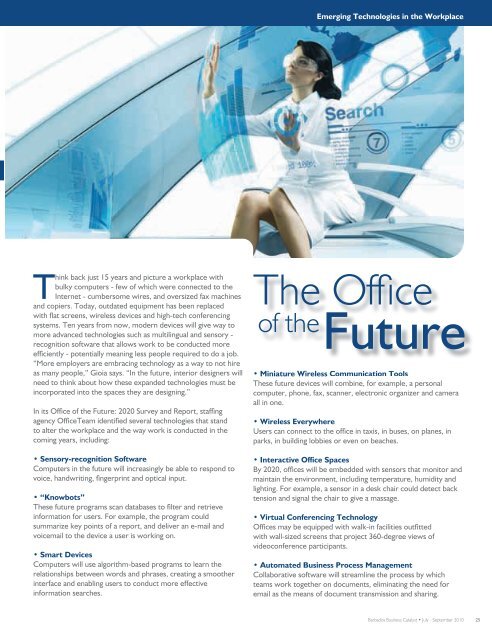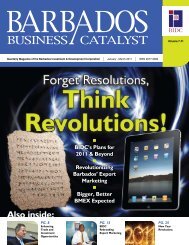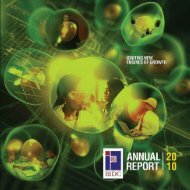BIDC Business Catalyst 6 #3.indd 1 12/21/10 3:17:07 PM
BIDC Business Catalyst 6 #3.indd 1 12/21/10 3:17:07 PM
BIDC Business Catalyst 6 #3.indd 1 12/21/10 3:17:07 PM
You also want an ePaper? Increase the reach of your titles
YUMPU automatically turns print PDFs into web optimized ePapers that Google loves.
Emerging Technologies in the Workplace<br />
Think back just 15 years and picture a workplace with<br />
bulky computers - few of which were connected to the<br />
Internet - cumbersome wires, and oversized fax machines<br />
and copiers. Today, outdated equipment has been replaced<br />
with flat screens, wireless devices and high-tech conferencing<br />
systems. Ten years from now, modern devices will give way to<br />
more advanced technologies such as multilingual and sensory -<br />
recognition software that allows work to be conducted more<br />
efficiently - potentially meaning less people required to do a job.<br />
“More employers are embracing technology as a way to not hire<br />
as many people,” Gioia says. “In the future, interior designers will<br />
need to think about how these expanded technologies must be<br />
incorporated into the spaces they are designing.”<br />
In its Office of the Future: 2020 Survey and Report, staffing<br />
agency OfficeTeam identified several technologies that stand<br />
to alter the workplace and the way work is conducted in the<br />
coming years, including:<br />
• Sensory-recognition Software<br />
Computers in the future will increasingly be able to respond to<br />
voice, handwriting, fingerprint and optical input.<br />
• “Knowbots”<br />
These future programs scan databases to filter and retrieve<br />
information for users. For example, the program could<br />
summarize key points of a report, and deliver an e-mail and<br />
voicemail to the device a user is working on.<br />
• Smart Devices<br />
Computers will use algorithm-based programs to learn the<br />
relationships between words and phrases, creating a smoother<br />
interface and enabling users to conduct more effective<br />
information searches.<br />
The Office<br />
of the<br />
Future<br />
• Miniature Wireless Communication Tools<br />
These future devices will combine, for example, a personal<br />
computer, phone, fax, scanner, electronic organizer and camera<br />
all in one.<br />
• Wireless Everywhere<br />
Users can connect to the office in taxis, in buses, on planes, in<br />
parks, in building lobbies or even on beaches.<br />
• Interactive Office Spaces<br />
By 2020, offices will be embedded with sensors that monitor and<br />
maintain the environment, including temperature, humidity and<br />
lighting. For example, a sensor in a desk chair could detect back<br />
tension and signal the chair to give a massage.<br />
• Virtual Conferencing Technology<br />
Offices may be equipped with walk-in facilities outfitted<br />
with wall-sized screens that project 360-degree views of<br />
videoconference participants.<br />
• Automated <strong>Business</strong> Process Management<br />
Collaborative software will streamline the process by which<br />
teams work together on documents, eliminating the need for<br />
email as the means of document transmission and sharing.<br />
Barbados <strong>Business</strong> <strong>Catalyst</strong> • July - September 20<strong>10</strong><br />
25









